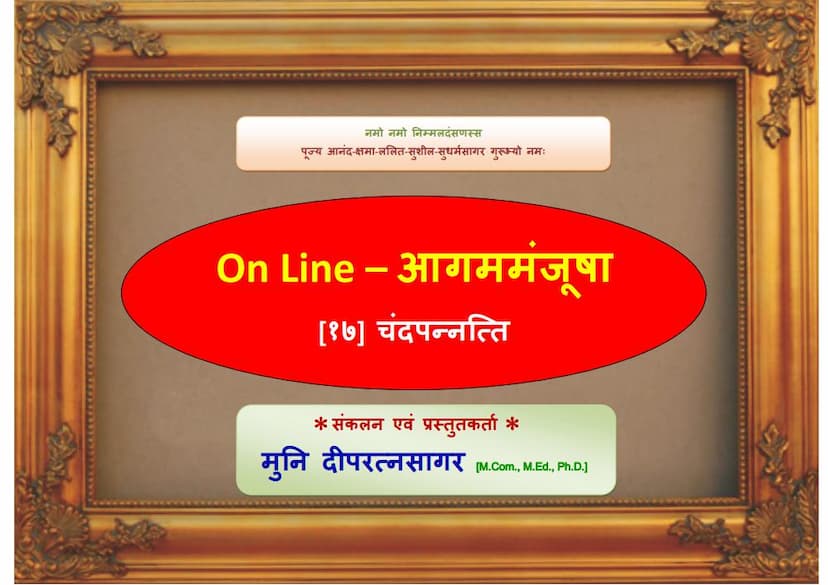Aagam Manjusha 17 Uvangsuttam Mool 06 Chandapannatti
Added to library: September 1, 2025

Summary
This Jain text, titled "Aagam Manjusha 17 Uvangsuttam Mool 06 Chandapannatti" and authored by Anandsagarsuri and Sagaranandsuri, published by Deepratnasagar, is a detailed exposition on the astronomical and calendrical aspects within Jainism. The text is a modernized online version of a work originally compiled around 70 years prior.
The core of the text, the Chandapannatti (Moon-Planetary treatise), delves into the intricate details of celestial bodies and their movements as understood in Jain cosmology. It focuses heavily on the sun and moon, their cycles, positions, and influence on timekeeping and various phenomena.
Here's a breakdown of the key themes and content:
Cosmology and Celestial Bodies:
- Sun and Moon: The text extensively details the movements, paths, and appearances of the sun and moon within the Jain universe. It discusses their orbits through various "mandals" (spheres or regions), the duration of their journeys, and the celestial mechanics involved.
- Stars and Constellations (Nakshatras): A significant portion is dedicated to the 27 lunar mansions (nakshatras), their individual characteristics, their positions relative to the moon and sun, and their roles in calendrical calculations and astrological interpretations. The text enumerates these nakshatras and describes their associations with specific deities and their own unique patterns.
- Planetary Movements and Interplay: The text outlines the complex interactions between the sun, moon, planets (grahas), and nakshatras, describing how they influence each other and contribute to the cosmic order.
- Cosmic Geography: It mentions geographical elements like Jambudvipa, Lavaṇa sea, and mountains like Meru, providing context for the celestial movements within this framework.
- Timekeeping: A central theme is the measurement of time through various units, including muhurtas (time units), days, nights, lunar months, solar years, and cyclical periods (yugas). The text explains how the movements of celestial bodies are used to demarcate and calculate these temporal units.
Key Concepts and Calculations:
- Mandals (Spheres): The sun's movement through numerous concentric celestial spheres or regions is meticulously described, including the number of spheres, their dimensions, and the sun's path through them.
- Half-Mandals (Ardhamandals): The text elaborates on the sun's movement through southern and northern half-mandals, detailing the changes in day and night lengths throughout the year.
- Prakashe (Luminosity) and Oghas (Flows/Influences): The text discusses how celestial bodies illuminate and influence different parts of the cosmos.
- Shadow Calculations (Chhaya): Detailed explanations are provided on how the length and nature of shadows cast by the sun are calculated at different times and seasons. This is a significant aspect of astronomical observation and timekeeping.
- Subtle Movements and Positions: The text goes into great detail about the precise angular and linear movements of celestial bodies, often expressed in complex units of measurement (yojanas, bhagas, etc.).
- Seasonal Cycles: The text connects celestial movements to the changing seasons and their characteristics, including the duration of specific seasons like Hemanta and Grishma.
- Lunar Phases (Purnimasi and Amavasya): The text describes the cycles of the moon, explaining how it waxes and wanes and its alignment with the sun and stars during full moon and new moon periods.
- Deities Associated with Celestial Bodies: The text lists the specific deities associated with various nakshatras, planets, and times of day, reflecting the interconnectedness of astronomy and spiritual beliefs.
- Yoga (Conjunctions and Combinations): The text discusses the concept of "yoga" in the context of celestial conjunctions, particularly between the moon and nakshatras, and the sun and nakshatras, often measured in specific time units.
Structure and Presentation:
- Pahuda (Sections/Chapters): The Chandapannatti is divided into numerous "pahudas" or sections, each addressing a specific aspect of celestial mechanics, timekeeping, or cosmology. These sections cover topics like the sun's movement, lunar phases, nakshatra classifications, time measurements, planetary positions, and the influences of Rahu.
- Paddhatti (Categories/Classifications): Within each section, concepts are further broken down into various "paddhatis" or classifications, presenting detailed information and different perspectives or calculations.
- Verses and Narrations: The text uses a combination of prose and verses (gathas) to explain complex concepts, often referencing previous teachings or traditional knowledge.
- Mathematical Precision: A remarkable aspect of the text is its attempt at mathematical precision in describing celestial movements, distances, and durations, using a specific system of units and fractions.
In essence, "Chandapannatti" as presented in "Aagam Manjusha" offers a glimpse into the sophisticated astronomical knowledge cultivated within the Jain tradition. It highlights a worldview where celestial bodies are not just physical entities but also carry immense significance in the spiritual and temporal fabric of the universe, guiding understanding of time, destiny, and the cosmic order.